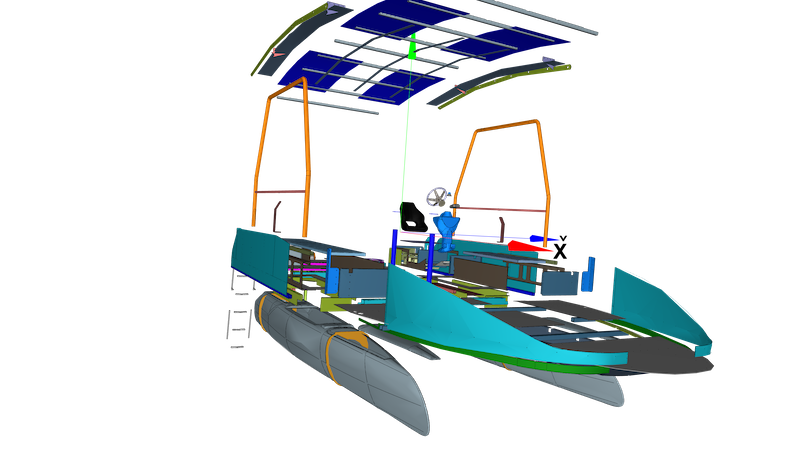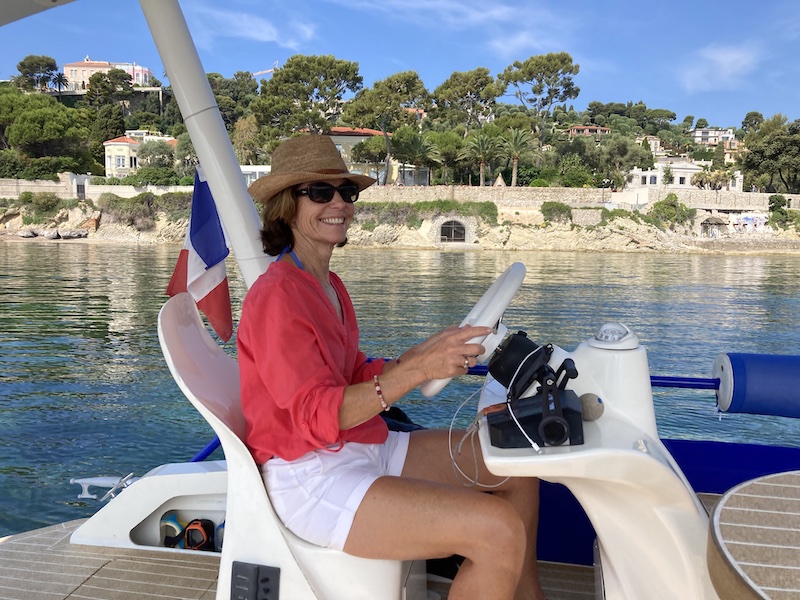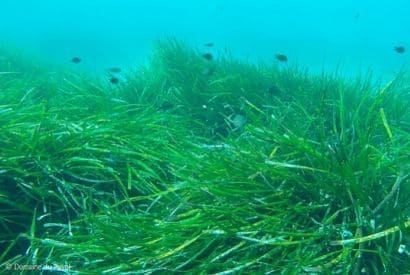Which boats in 2030? Synthetic fuel...
The automotive and aeronautical industries are setting the course for yachting. Reading 4 reference reports allows us to draw conclusions. From 2030, the market will be electric, hydrogen is not for tomorrow, boats will be more frugal. This will not be experienced as a regression and this is the main revelation of these reports, because the changes in use go hand in hand with the evolution of mentalities. Guillaume Jacquet-Lagrèze, founder of Seazen, shares with you the synthesis of these readings after having confronted his ideas with 5000 boaters.
- The real issues
- What do the 4 reports on boating, cars, aviation and RTE tell us?
- Towards an energy Yalta
- What future for yachting?
- Our sources: the 4 reports cited in this article
The real issues
As recreational boating is responsible for less than 0.1% of global emissions, it may be urgent to wait.
However, the groundswell of transition is likely to transform demand. We are already hearing about the "flygskam" or "flight shame" in air travel. Will the consumer of 2030 still enjoy buying a vehicle with an internal combustion engine and filling up with fossil fuel from abroad? This is the big question for the marine industry.
Without claiming to read the future in a crystal ball, reading several hundred pages of reference reports teaches us a lot. We offer a synthesis of these readings and then put them from the perspective of the boating industry and our experience of the public's reactions to carbon-free boating. The reader of this article can easily verify our conclusions in the sources cited (in French!).
Lessons from the 4 reports
Report #1 on the boating of tomorrow
Lesson #1: the future of boating depends on externalities
The reference report written by the nautical sector at the request of the Minister of the Sea mainly addresses the aspects of dismantling, training, administrative simplification, new uses and safety. The good news is that the French industry is the leader in boat dismantling, and can be legitimately proud of this! But the authors of this report also point out the industry's dependence on externalities. To measure this, here is a comparison of the respective weight of the Nautical, Automotive and Aeronautical industries.
| 2019 figures | Billion € |
| Motorboat and sailing boat production | 1 |
| Manufacture of motor vehicles | 109 |
| Aircraft construction | 110 |
Clearly the solutions will not come from the marine industry. Let's look at these other industries and come back to boating later in this article.
Report #2 on the automotive transformation plan
Lesson #2: Attitudes will be nothing like they are today
Let's start our examination of externalities by reading the plan for the transformation to the electric car written by The Shift Project. This report is a benchmark, especially as the car industry is very interested in changes in society.
To begin with, and this has already been announced many times, by 2050 there will be no more new fossil-fuelled cars. More surprisingly, there will be no hydrogen-powered electric cars (with fuel cells) either. This point is worth noting because it confirms an issue raised in the aeronautics plan discussed below.
In 2050 there will be no fossil fuel or hydrogen cars.
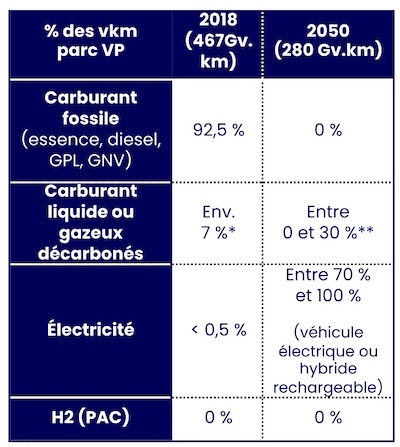
Source Shift Project, PTEF Automobile page 91
Let's move on from the report and get back to the economic news. The difficulties of the transition are such that the PFA, the automobile 'lobby', is asking Europe to delay the 2050 all-electric deadline. It is therefore surprising to see manufacturers racing to be the first to announce to the public a switch to 100% electric cars as early as ... 2030 or 2025. Already twenty or so manufacturers will be all-electric by 2030. These include Jaguar, Stellantis, Renault, Volvo, Mercedes and even Rolls Royce, which has announced that going electric is in keeping with the spirit of the brand.
Why make such a dangerous announcement race when the European regulations only talk about 55% electric cars by 2035 and when The Shift Project talks about 2050? Is it just to exist in the face of competition from Tesla?
Let's go back to the Shift Project report. We see that the thermal car will be replaced in favour of two-wheelers, quadricycles or bicycles, all of which are electric.
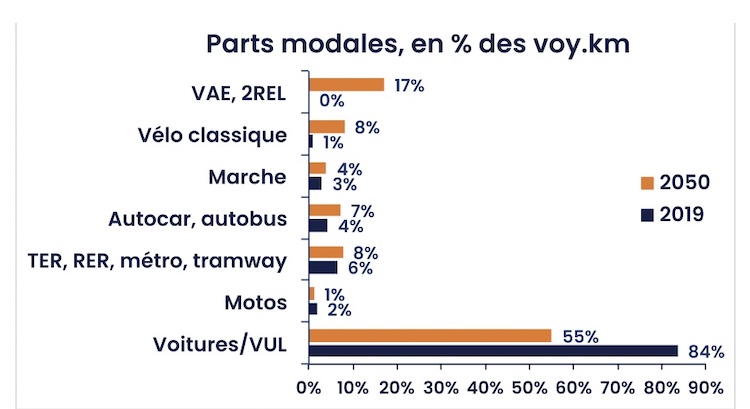
Source Shift Project, PTEF Automobile page 69
In fact, a large part of the energy transition will be achieved through changes in usage. Isn't it more beneficial for our health to make short trips by bike or on foot than to take the car? Common sense is the first winner in the energy transition.
But here's the problem: the more individuals are equipped with scooters and electric bikes, the more they will be reluctant to get into a smelly combustion engine vehicle that wakes up the neighbourhood. In marketing, this is called cognitive consistency. It is a powerful lever for changing behaviour, as illustrated by the success of anti-smoking campaigns. Remember that a few years were enough to transform the behaviour of smokers in restaurants. The automotive industry may see this "psychological tipping point" for 2030 without daring to say so.
The boating industry must imagine the unthinkable! The boater of 2030 will not be the boater we know in 2022. It seems coherent to imagine that many boaters will want to sail electrically at the same time as they ride scooters, bicycles, quad bikes or electric cars. Cognitive coherence will not stop at the harbour quay!
Report #3 on the aeronautics transformation plan
Lesson #3: there will not be hydrogen for everyone
Aeronautics will also see a change in usage. For example, short flights will switch to train travel. But how will the many remaining aircraft make the transition? Aviation relies on hydrogen, which mainly requires electricity to be produced. This is where it becomes interesting for boaters...
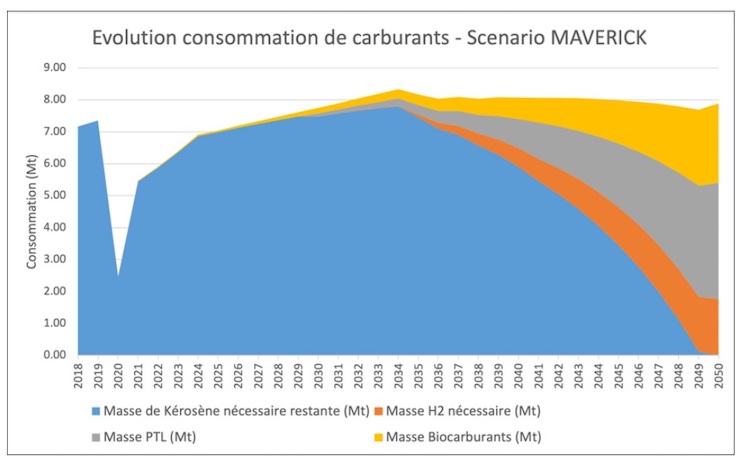
By 2030, energy companies will have to provide hydrogen to produce PTL synthetic fuels or even to power aircraft
Source Shift Project, PTEF Automobile page 77
In relative terms, the need for hydrogen seems negligible on this graph. But in absolute terms, according to the authors of this report, in 2050 it would be necessary to install 8 times as many wind turbines on French territory and to devote all of them to the production of green hydrogen for aeronautics.
Clearly, if other industries than aeronautics, for example the nautical industry which weighs 100 times less, would like to set up a hydrogen supply chain, it would be necessary to find a way to deprive aeronautics which will already have difficulty in obtaining supplies. And incidentally we assume that sailors will welcome wind turbines in their fishing grounds to produce electricity that will be used to produce hydrogen!
Report #4 from RTE
Lesson #4: the consumption of ships must be reduced by 40%
Let's take a little more perspective by summarising the results of the report by RTE, the French electricity network manager, which is also a reference. The energy transition aims to replace what we do today with fossil fuels with decarbonised electricity-based solutions such as wind, solar, nuclear or dams. When it is not possible to do without fuel, there will be synthetic fuels or biofuels. However, synthetic fuel will only be produced at competitive prices if it is mass-produced, and of course also from electrical energy. This is called Power to Liquid. Whatever we do, the need for electricity production will increase tenfold as a result of the energy transition.
Fortunately, global energy consumption will fall from 1600 to 930 TWh thanks to energy savings of 40%. Overall, the share of electricity consumption will increase from 25% to 55%. In this diagram, we can see a few TWh for green hydrogen. It will be reserved for our friends in aeronautics and industry. It is easy to imagine that maritime passenger transport will also get some leftovers because this public transport is of public interest.
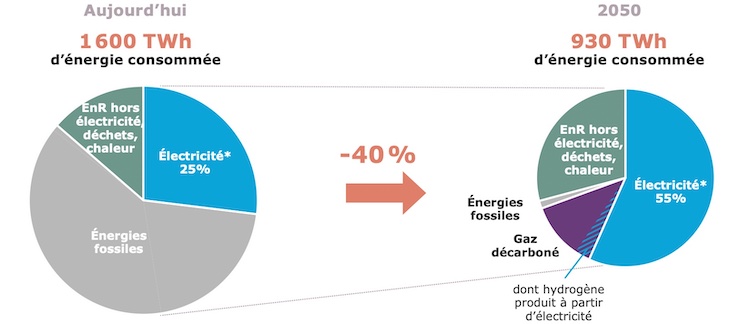
How can we believe in available hydrogen for "rich boaters" if there is a shortage?
Source Fig 1.3 du Rapport Complet RTE avec Stratégie Nationale Bas Carbone
Jean-Marc Jancovici makes the point that the 30 glorious years taught us to live in a world of energy abundance and that the transition teaches us to aim for frugality. He makes it clear that frugality is not an impoverishment of society because it responds to an evolution in demand.
In a rationed universe and in competition with other sectors, nothing suggests that the nautical sector will be able to convince the public authorities to grant them too large a share of the energy cake. So, all things being equal, the yachting industry will have to save 40% of its consumption compared to today.
Towards an energy Yalta
Superb hydrogen-powered yachts are coming onto the market with a promising future for yachting. Other boat builders are betting on the arrival of synthetic fuels, and still other builders believe that large batteries will store enough energy to take them to Corsica!
Let's not forget once again that the hydrogen used for Fuel Cells, or any synthetic fuel, has to be green to be used in the energy transition. This means using huge quantities of electricity just to produce these fuels. We would probably have to double our electricity production capacity. How many nuclear power plants or solar panels do we want in the countryside? That's going to take time. Clearly, there won't be enough for everyone for many years to come. So we're heading for an energy Yalta.
In this Yalta, the nautical sector does not have the same economic weight as the automotive and aviation sectors in sharing a resource that will become scarce. From a purely technical point of view, airplanes are likely to take priority over cars, because they simply can't fly on batteries. From the point of view of the general interest, fuel for passenger transport will inevitably take priority over private use in the event of a shortage. So the private yacht, which doesn't tick any boxes, will probably be the last to be able to use synthetic fuels or hydrogen or mega-battery chargers.
The future of boating in 2030?
Let's go back to the consumer of 2030. His expectations are different from those of today. They think in terms of all-electricity because the uses of cars, planes and transport are evolving at the same time.
Given the time needed to develop a new technology in the marine sector, we should not expect miracle solutions to emerge if they are not already known now.
We already know the technologies and their limits
There is always sailing, that's a certainty, and that's good news because it's a mature know-how. As for the electric motors that will equip the boats, they are powered by batteries. The 8 years remaining between now and 2030 offer a very short timeframe for renewing the entire pleasure boat fleet. Many boat owners will prefer to invest in electric boat refurbishment, or Retrofit. Buyers of new boats may be tempted by new types of vessels, perhaps foils to reduce consumption or solar boats to increase autonomy.
Since the boat will not be able to carry the same energy density, it will be less fast and less autonomous overall. Are we talking about regression or progress?
To answer this question, let's take the concrete uses of the yachtsmen of the Côte d'Azur that we know well.
The day trip will be a moment of pure zenitude
Many small boat owners use it for a few hours outing. A swim in the sea, an aperitif or a siesta. On average, the Mediterranean offers a port every 4 kilometres. So it only takes a few minutes of sailing to anchor in a dream anchorage. Most of the time, the oil in the combustion engines has not had time to warm up before the boat reaches its destination. This use of the dayboat is particularly suitable for electric sailing. The engine and a small battery are more than enough.
Many boaters like to sail to different anchorages each time. For them, the boat club is the right service for trips from different harbours without having to do any paperwork and at an attractive price. The boat club is more zen without the hassle of ownership.
The cruise will be an ode to contemplation
If the crew is in love with the sea and sailing, speed is not important. The electric sailing programme will be slower to preserve battery life. All in all, it will be quite similar to that of sailing boats. Sailing will always be a moment of pleasure, lulled by the lapping of the waves to enjoy a meal, contemplate the landscape and converse with friends and family.
Fountaine Pajot also sets course for 2030 for the energy transition
"life cycle [...] 80% of CO2 emissions come from the use phase of the boat"
How to try it?
Still not convinced after reading this? We have welcomed more than 10,000 people to solar sailing, and every visitor has told us that they have experienced a great deal of pleasure in sailing more quietly! So here's our last piece of advice: come and see us and try it for yourself, because electrics give a new meaning to the word boating.
*****************************
The 4 reference reports at the source of this article
1) The FIN report for the Minister for the Sea
Title : The Nautical Industry of Tomorrow
Authors: Yves Lyon-Caen, President of the Federation of Nautical Industries
Guillaume Sellier, Interregional Director of the Sea, North Atlantic - West Channel
Published in December 2021 on the website of the Federation of Nautical Industries
Consultation of the report on the FIN website
Extract: "If innovation is abundant, it is mainly an innovation of continuity and not of rupture. ... the builders are designers-assemblers, who depend to a large extent on the innovations of their suppliers (the engine manufacturers for the engines, the chemical industry for the hulls, the equipment manufacturers, etc.)".
Nb: SeaZen thanks the industry for having interviewed them for this report, which in turn inspired this article
2) The PTEF (Energy Transformation Plan) for the automotive industry
Title : The low carbon transition, an opportunity for the French automotive industry
Author: The Shifters
Published in November 2021 by the Shift Project
Consultation of the Automotive report on the Shift Project Automotive website
3) The PTEF (Energy Transformation Plan) for the aeronautics industry
Title : Being able to fly in 2050: what aviation in a constrained world?
Author: the Shifters
Published in March 2021 by the Shift Project
Consultation of the Aeronautics report on the Shift Project website
Excerpts:
Page 78: "The electrical energy required to produce these quantities of PtL and H is 265 TWh (165 TWh for PtL and 100 TWh for H2), which would require a wind farm dedicated to air transport approximately 8 times greater than the total French wind farm installed in 2019"; "The "MAVERICK" scenario as it stands does not make it possible to achieve the decarbonisation objectives and generates considerable energy externalities, at a level that has probably not been anticipated to date by the French hydrogen and energy sector. Accelerating the rate of production of alternative fuel would nevertheless make it possible to improve it, without respecting the carbon budget. It is therefore very risky and unrealistic as it stands.
4) The RTE repport
Title: Energy Futures 2050: the production mix scenarios under study for achieving carbon neutrality by 2050
Updated February 2022


